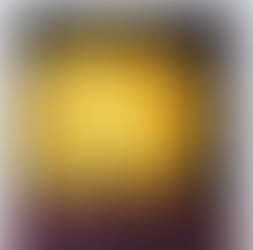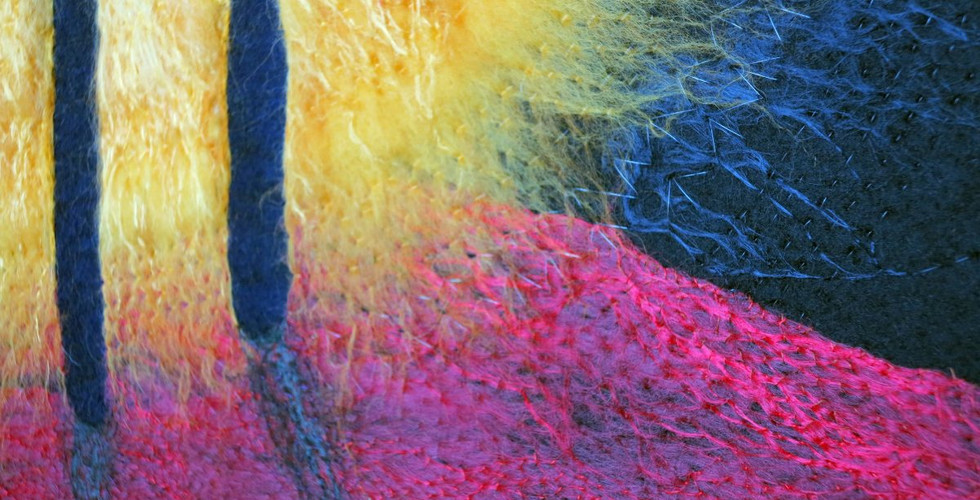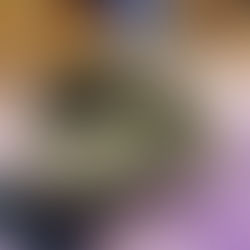- May 11, 2021
- 2 min read
I am so excited to announce that my art quilt, Cycles of Time and Space, is in the Crocker Art Museum’s 2021 Silent Auction and is available to bid on right now!

This post is to show what happens behind the scenes - the creative process, if you will. This piece was a tricky one, to say the least. I finished it during a very difficult time in my life, and though I wasn't happy with the (first) result, I didn't have the energy to break through the invisible barrier that was preventing me from realizing the full potential of this piece. I put it away in storage, thinking that I would never let anyone see it, I was so dissatisfied with it. Then, maybe 9 months later, after I had developed new techniques with new materials, I decided to pull out this artwork and give it a new life.
It is not recommended to "finish" a work and then decide that it's not finished. I had to remove/undo a lot of the finishing work in order to continue, such as the label, the velcro for hanging and the binding. Sometimes making textile art involves a lot of hassle.
On the left, the original figures and background created with hand embroidery. On the right, a photo which shows the more or less original idea for the work, before I began making a lot of changes.
It was difficult for me to realize what was lacking and therefore what was needed. I dyed the bottom half a darker color. I started playing around with adding fibers to the surface, and debated whether or not to add a "veil" of silk organza (which I ended up doing).
I played around with different orientations and decided to flip the piece 180 degrees. Below you can see this change and the beginning of the stitching over the organza. In the middle picture, the stitching is completed. To me, the artwork was definitely improved, and had a soft, atmospheric presence, which I really liked. But I still thought it needed something. Using photo editing software, I tested out a few more ideas and decided to subtly add some 4th dimensional geometric shapes, using hand embroidery.
Finally, this piece became something which I'm happy to show the world, and offer for purchase to lovers of art!

This year’s Art Auction Season taking place online using the Bidsquare platform and is open for everyone to participate! Please visit: www.crockerart.org/artauction to learn about the Crocker’s Art Auction Season. If you’re already a Bidsquare pro, you can view the works at
www.bidsquare.com/auction-house/crocker-art-museum. Registration is free for everyone, and
bidding is now open!
Support raised from this year’s Art Auction Season is critical for the Crocker and for the
thousands of children, families, and adults the Museum serves every year. Your generous
support is needed now more than ever.
Thank you for your support!
Shea
- Apr 21, 2021
- 1 min read

Perhaps due to spring, and the elongated days here in Siberia, this new piece is inspired by the sun's warm rays, bursting with energy. My new direction of exploration is towards slightly sculptural 3-d work, and this is piece is the second in which I've incorporated some extra volume. As opposed to the first work, this one was planned from the beginning to have some extra thickness.

These several photos show the basic process, from sketching out the figures so that I had a constant reference, to laying the fibers down where I wanted them, to cutting out the unwanted fibers. After all that was finished, I stitched around the figures to secure the fibers and finally needle felted everything in place.

Detail images:
- Apr 18, 2021
- 4 min read
See more images here.
In today’s world of fast production to fast waste, it’s hard to envision what we could possibly pass down to the next generation 25 years from now. Consider the world of toys. I recently saw a friend’s picture with her toddler riding in one of those red and yellow plastic cars that were so familiar in the 80s and early 90s. Her parents had been saving it for their future grandchildren. It brought back so many great memories for me, as I adored those cars as a kid.
I wonder to myself what I would be able to give my grandchildren far in the future. Toys today are often of a trendy nature, the latest superheroes recently featured in a Hollywood movie, or pervasive cartoon characters who will be forgotten within the year by our fickle-minded children. Not only that, but the materials are often of a doubtful quality and origin, leaving parents with endless “what-ifs”.
So, when considering what you can pass on to your children and grandchildren, and even great-grandchildren, there are 3 primary factors to keep in mind: Materials, Craftsmanship, and Design. These elements will guarantee the longevity and relevance of the toy for decades to come.
Material. Children are tactile creatures. They crave stimulation, which can only be satisfied by fascinating textures. So why are we handing them smooth plastic, which does nothing to sate their need for tactile stimulation. Plastic can also be brittle and potentially contain harmful chemicals. Toys which contain fabrics are a good option in many ways, though their downside is that with repeated use, the seams may rip and fabric become tattered and stained. I believe that felted wool is one of the best materials for toys. It is very strong and durable, doesn’t have any seams or edges that can rip and fray, and the best part of all, in my opinion, is its unique and interesting texture. It also naturally repels water, so the inevitable spills which occur with children are not a big threat if treated within a reasonable amount of time, unlike with standard fabrics. It is washable for regular maintenance, although wool is also naturally antibacterial, so smells are typically not an issue, even if your child plays with it constantly.

Craftsmanship. If you want a toy to last for 25 - 100 years, there must be a high level of craftsmanship. Factory-produced toys will rarely reach this level, as their aim is to constantly sell you new toys based on the newest trends. If it breaks in a year, it only means that now you can update your toy to the new coolest trendy character. But of course that’s a waste of money and resources, and landfills are filled to the brim with chucked out toys. Wooden toys often exhibit a very high quality of craftsmanship and perhaps are the longest lasting of all toys. Cloth toys have various levels of craftsmanship with varying durability. One must be more careful with this style of toy that the seams are wide and strong enough to withstand active use without coming undone. Fabric is also created with differing levels of quality, so there are several factors to consider here. With felted wool, there’s little that can go wrong in the craftsmanship. The nature of felted wool is such that many loose wool fibers are forced together to create a cloth. There are no seams which can come undone, and even if one area is rubbed or worn more than another, the wool is many layers thick and much less likely to result in a hole than fabric, where if one thread gets broken, it can be the beginning of an ever-increasing hole. When felting, there is the possibility that the item can be under-felted, but even in that case, the felt is still considerably stronger than fabric and low-quality plastics.
Design. We all know that trends come and go, and, if lucky, sometimes return and fade back again into the background of history. In the history of toys, only a few characters, like Winnie the Pooh, have really stood the test of time, but I don’t see any contemporary classics out there on the shelves today. Take Power Rangers, for example. I remember when they were the coolest. Today’s kids would probably laugh in my face if I tried to get them to play with one now. And have you noticed how monsters have started to appear everywhere? Why do we want to expose our children and grandchildren to such ugliness, especially when the world has enough scary realities without adding to it.
So how do you plan for the next several decades? Choose what has already survived the test of time for centuries - reflections of the natural world. Kids have always and will always love animals and people. Choose classic or humorous representations of your child’s favorite animal. Your grandchild will appreciate having something which was loved by his or her parent. Or something as simple as a cat or a dog can be enjoyed by nearly any child in any time period, now or 50 years from now. While some things are always changing, some things always stay the same.
In conclusion, if you’re a long-term planner like me, and are thinking about what special contribution you can make to your family story in the future, consider the special act of passing down a beloved childhood toy from generation to generation. I make Kandinsky Studio hand puppets with this goal in mind, to create something from quality materials, using a high level of craftsmanship and classic designs that can stand the test of time. I value quality at all levels of production and strive to make items which will be cherished for many years, from childhood through adulthood and then onto the next generation.
Check out my hand puppets here and let me know if there’s a special animal or person who would fit the personality of your child or grandchild, and I’ll be happy to try to fulfill such requests.
.png)






































































































